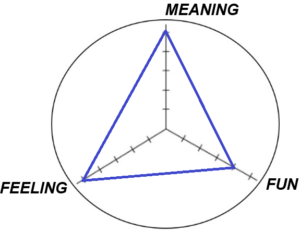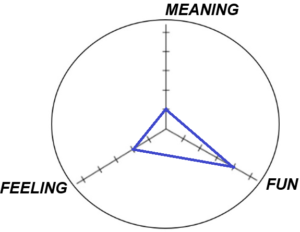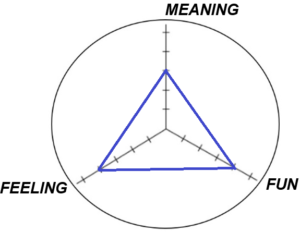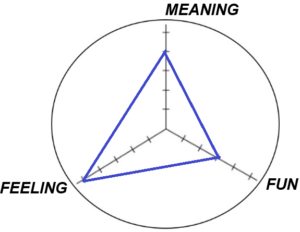The things that appeal to me in books fall into three categories. Making each of them an axis at 120 degree angles, and plotting the quality of a book on these three axes creates a triangle, the area of which indicates the overall merit of the book.
That’s the idea, one I had on the bus the other day.
The scale would look like a bit like the Mercedes emblem. (And that’s the full extent of the automotive reference.)

The vertical axis reflects Meaning. This has to do with the insights and ideas in the book. It could also include formal innovation and social commentary. Books that score high on this axis could be called “fascinating”, “deep”, “challenging” or even “life-changing”. These books win literary awards.
The left axis reflects Feeling. This has to do with the emotional appeal of things in the book, e.g. the characters, setting or theme. Books that score high on this axis could be called “engaging”, “charming” or “right up my alley”. These books travel in backpacks and linger on bedside tables.
The right axis reflects Fun. This has to do with action, tension, the thrust of the plot, humour and the prose itself. Books that score high on this axis could be called “enjoyable”, “thrilling” or “unputdownable”. These books dominate bestseller lists (though seldom because of humour, and never because of the prose).
Now, using a scale where 1 is the lowest possible rating and 5 the highest, let’s plot some books on this scale to see what it might look like, based on my fallible judgement.
The Brothers Karamazov – Fyodor Dostoevsky (contender for best novel ever)
The Sound of Thunder – Wilbur Smith (which I translated a few years ago)
Death’s Dark Abyss – Massimo Carlotto (favourite book I’ve read in recent years)
The Following Story – Cees Nooteboom (probably the book I’ve reread most times)
Anyway, you get the idea.
My own books tend to rate higher on the Feeling and Fun axes, rather on the Meaning scale.



